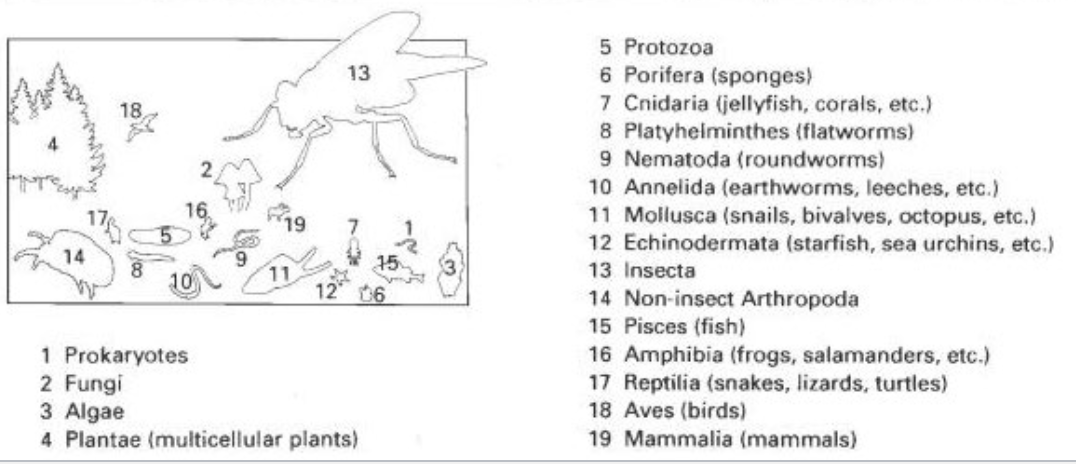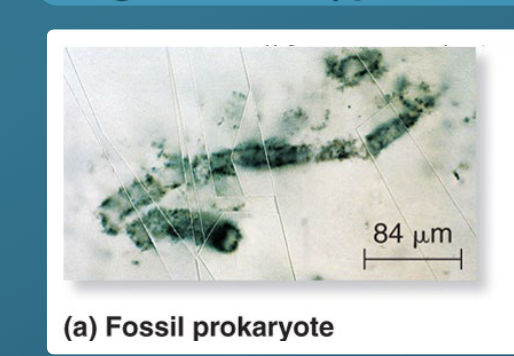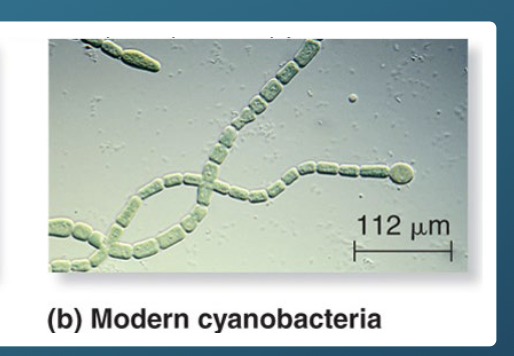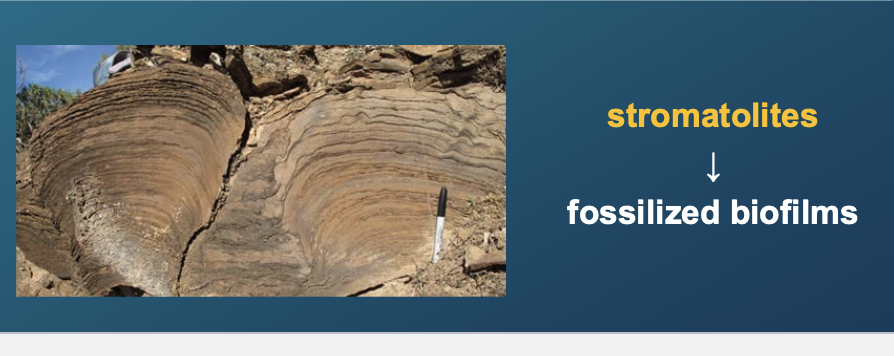BIO 2 Exam 1 Review
0.0(0)
Card Sorting
1/115
Earn XP
Description and Tags
Study Analytics
Name | Mastery | Learn | Test | Matching | Spaced |
|---|
No study sessions yet.
116 Terms
1
New cards
artificial selection can be achieved through
selective breeding
2
New cards
species
basic lower unit of classification of organisms
3
New cards
taxonomy
the science of classification of organisms
4
New cards

protozoa
single-celled eukaryotes, either free-living or parasitic ex:amoeba
5
New cards
porifera
sponges (think pores “pore” infera)
6
New cards
Why are insects so diverse?
Small body size - There are many opportunities for small organisms in a given environment
7
New cards
Why are insects so small?
1. It takes time to grow large - A long juvenile period increases the risk of mortality before reproduction
2. Oxygen limitation - Gas exchange becomes difficult at large sizes because of distance effects on oxygen diffusion
8
New cards
Tympana
A thin cuticular membrane that allows for hearing in insects also mating calls
9
New cards
Cnidaria
jellyfish, coral etc.
10
New cards
sound
Pressure fluctuation transmitted in a wave-form via movement of air or water
11
New cards
Hypothese on origins that have 4 overlapping stages
1. appearance of organic molecules
2. polymerization of molecules into RNA, DNA, or proteins
3. formation of protobionts
4. evolution of cell-like characteristics
12
New cards
minimal properties of life
reproduction, metabolism, evolution
13
New cards
hypotheses about how/where organic molecules originated
1. reduced atmosphere hypothesis
2. extraterrestrial hypothesis
3. deep sea vent hypothesis
14
New cards
Metabolism
Absorption of nutrients, waste excretion, energy acquisition and transformation, and cellular synthesis
15
New cards
Miller-Urey 1952 Experiment
Set up anaerobic atmospheric conditions and added an electrical discharge, resulting in the spontaneous formation of simple organic molecules
16
New cards
Extraterrestrial hypothesis
Meteorites brought organic carbon to Earth
17
New cards
Protobiont
Aggregate of molecules and macromolecules that acquired a boundary, allowing it to maintain an internal environment separated from its surroundings
18
New cards
What makes protobionts possible precursors to living cells?
1. A boundary separated external environment from internal contents
2. Polymers inside the protobiont contained information
3. Polymers inside the protobiont had enzymatic function
4. Protobionts capable of self-replication
19
New cards
living cells may have evolved from
coacervates-droplets that form spontaneously from charged polymers where enzymes trapped inside perform metabolic functions
liposomes-can enclose RNA
liposomes-can enclose RNA
20
New cards
what is the first macromolecule of protobionts
RNA
21
New cards
what are functions of RNA
1. ability to store info
2. self-replication
3. enzymatic function (ribozymes)
22
New cards
Radioisotope dating
A common way to estimate the age of a fossil by analyzing the decay of radioisotopes within the rock (usually igneous rock)
23
New cards
Half-life
Length of time required for exactly one-half of original isotope to decay
24
New cards
Factors that affect the completeness of the fossil record:
1. anatomy
2. size
3. number
4. environment
5. time
6. geological processes
7. paleontology
25
New cards
fossil prokaryote

26
New cards
cyanobacteria

27
New cards
stromatolites

28
New cards
changes in living organisms due to
genetic changes and changes in environment which allow for new organisms and extinctions
29
New cards
Cretaceous
\- 144-65 MYA \n -Dinosaurs still dominant \n -Angiosperms - earliest flowering plants \n -Mass extinction at end wiped out dinosaurs and many other species
30
New cards
Macroevolution
The formation of new species or groups of related species
31
New cards
Lamarck
Proposed theory that organisms pass on traits they acquire in their lifetime. (Incorrect) i.e. Scars
32
New cards
Charles Darwin
English natural scientist who formulated a theory of evolution by natural selection
33
New cards
Darwin's Theory of Evolution based on:
1. Variation within a given species
2. Natural selection
34
New cards
Population genetics
The study of genes and genotypes in a population
35
New cards
Purpose of Population Genetics:
1. To know extent of genetic variation
2. Why it exists
3. How it is maintained
4. How it changes over the course of many generations
36
New cards
Phenotype
Physical appearance or observed traits due to genotype
37
New cards
Natural selection
A process in which individuals that have certain inherited traits tend to survive and reproduce at higher rates than other individuals because of those traits.
38
New cards
Reproductive success
Likelihood of an individual contributing fertile offspring to the next generation
39
New cards
Horizontal gene transfer
Transfer of genes between cells of the same generation
40
New cards
Permian-Triassic Extinction Event
252 MYA, the only known mass extinction of insects \n - 8 or 9 orders became extinct
41
New cards
Paleodictyopterida
An extinct superorder of beaked insects \n - Included 50% of all known Paleozoic insects
42
New cards
Ultrasonic pulses
Method by which echolocating bats detect prey
43
New cards
Phantom Echo hypothesis
Bat perceives clicks as multiple objects surrounding the moth
44
New cards
Ranging Interference hypothesis
Bat perceives clicks as a blurred target
45
New cards
Masking hypothesis
Bat perceives clicks as no target
46
New cards
Four periods of the Earth
Archaen, Proterozoic, Phanerozoic, Cenozoic
47
New cards
Life
An organized genetic unit capable of metabolism, reproduction, and evolution
48
New cards
Reproduction
Growth, duplication of all cellular components, division of discrete cells
49
New cards
Evolution
Variation, reproduction, and mutation
50
New cards
Origin of Life: Stage 1
Nucleotides and amino acids spontaneously produced prior to the existence of cells (Primordial soup)
51
New cards
Origin of Life: Stage 2
Nucleotides and amino acids became polymerized to form DNA, RNA, and proteins
52
New cards
Origin of Life: Stage 3
Polymers became enclosed in membranes, separating them from the environment
53
New cards
Origin of Life: Stage 4
Polymers enclosed in membranes acquired cellular properties
54
New cards
Reducing Atmosphere hypothesis
Atmospheric reactions with lightning, solar, and cosmic radiation
55
New cards
Deep-sea Vent hypothesis
Biologically important molecules may have been formed in the temperature gradient between extremely hot vent water and cold ocean water
56
New cards
Coacervates
Droplets that form spontaneously from the association of charge polymers
57
New cards
Liposomes
Vesicles surrounded by a lipid layer
58
New cards
Key functions of RNA:
1. Ability to store information
2. Capacity for self-replication
3. Enzymatic function
59
New cards
Sedimentary rock
Comprised of many layers. Sediments pile up and become rock
60
New cards
Stromatolites
Fossilized biofilms, form in layers. Can be used to extrapolate fossilized prokaryotes
61
New cards
Changes in living organisms are the result of:
1. genetic changes
2. environmental changes
62
New cards
Major environmental changes:
1. climate/temperature
2. atmosphere
3. landmasses
4. floods
5. glaciation
6. volcanic eruptions
7. meterorite impacts
63
New cards
Archaen
\-3.8 to 2.5 BYA \n -First cells are prokaryotic and heterotrophic \n -Little free oxygen, organisms were anaerobic \n -Autotrophs evolved as supply of organic molecules dwindled
64
New cards
Proterozoic
\-2.5 BYA-543 MYA \n -Multicellular eukaryotes arise 1.5 BYA \n -First animals are invertebrates \n -Bilateral symmetry facilitates locomotion
65
New cards
Cambrian
\- 543-490 MYA \n -Warm and wet with no ice at poles \n -Cambrian Explosion - abrupt increase in diversity of animal species (unknown cause) \n -All existing major types of marine invertebrates that no longer exist
66
New cards
Ordovician
\- 490-443 MYA \n -Diverse group of marine invertebrates including trilobites and brachiopods \n -Primitive land plants and arthropods first invade land \n -Towards end, abrupt climate change results in mass extinction (60% of marine invertebrates go extinct)
67
New cards
Silurian
\- 443-417 MYA \n -Coral reefs appeared \n -Large colonization by terrestrial plants and animals \n -Spiders and centipedes \n -Earliest vascular species
68
New cards
Devonian
\- 417-354 MYA \n -Ferns, horsetails, and seed plants (gymnosperms) \n -Insects emerge \n -Amphibians (tetrapods) emerge \n -Near end, series of extinctions eliminate many marine species \n -"Age of fish"
69
New cards
Carboniferous
\- 354-290 MYA \n -Rich coal deposits formed \n -Very large plants, trees, amphibians prevalent \n -First flying insects \n -Amniotic (terrestrially-adapted) egg emerges
70
New cards
Permian
* 290-248 MYA
\-Pangaea
* Amphibians prevalent, reptiles dominant
\-First mammal-like reptiles appeared
\-Largest known mass extinction event at the end (90-95% of marine species)
\-Pangaea
* Amphibians prevalent, reptiles dominant
\-First mammal-like reptiles appeared
\-Largest known mass extinction event at the end (90-95% of marine species)
71
New cards
Triassic
\- 248-206 MYA \n -Reptiles plentiful \n -First dinosaurs and first true mammals \n -Gymosperms dominant land plant \n -Volcanic eruptions led to global warming and mass extinctions near end
72
New cards
Jurassic
\- 206-144 MYA \n -Gymnosperms still dominant \n -Dinosaurs dominant land animals \n -First known bird \n -Mammals present but not prevalent
73
New cards
Tertiary
\- 65-1.8 MYA \n -Mammals that survived expanded rapidly \n -Angiosperms became dominant land plant \n -Whales appeared \n -Hominoids appeared 7 MYA
74
New cards
Quarternary
\- 1.8 MYA to present \n -Periodic ice ages cover Europe and North America \n -Certain hominoids become more human-like \n -Homo sapiens appear 130,000 years ago
75
New cards
Geological Time Scale
1. Archaen - bacteria and archaea
2. Proterozoic - eukaryotes
3. Phanerozoic - Paleozoic (land colonized), Mesozoic (dinosaurs), Cenozoic (hominoids)
76
New cards
Ring of Cenotes
Modern-day signature of the subsurface Chicxulub crater
77
New cards
Chicxulub crater
Location of meteor impact that killed the dinosaurs at the end of the Cretaceous
78
New cards
Evolution
Heritable change in one or more characteristics of a population from one generation to the next
79
New cards
Microevolution
Changes in allele frequency in a population over time
80
New cards
Population
All members of a species that live in the same area and have the opportunity to interbreed
81
New cards
Linnaeus
Classified nature with a nested hierarchy (binomial nomenclature)
82
New cards
Observations of Evolutionary Change:
1. Fossils
2. Biogeography
3. Convergent evolution
4. Artificial selection
5. Homology
83
New cards
Biogeography
Study of the geographical distribution of extinct and living species
84
New cards
Convergent evolution
Two different species from different lineages show similar characteristics because they occupy similar environments
85
New cards
Artificial selection
Programs and procedures designed to modify traits in domesticated species
86
New cards
Anatomical homology
Fundamental similarity due to descent from a common ancestor (ex: human hands and bat wings)
87
New cards
Molecular homology
DNA sequences of related species tend to be similar
88
New cards
p53 proteins
Plays a role in preventing cancer
89
New cards
Molecular processes that underlie evolution:
1. Homologous genes
2. Gene duplication
3. Exon shuffling
4. Horizontal gene transfer
5. Genomic level changes
90
New cards
Homologous genes
2 genes derived from the same ancestral gene
91
New cards
Paralogs
Homologous genes within a single species
92
New cards
Exon shuffling
When an exon (parts of a gene that encode protein domains) and the flanking introns are inserted into a gene
93
New cards
Genomic level changes
Large changes in chromosome structure and number
94
New cards
Allele
A variant form of a gene
95
New cards
Genotype
Genetic makeup or hereditary information composed of multiple alleles
96
New cards
Allele frequency
\# of copies of an allele/total # of alleles in a population
97
New cards
Genotype frequency
\# of Indies with a particular genotype/ total # of indivs in a population
98
New cards
Hardy-Weinberg equation
p2 + 2pq + q2 = 1
99
New cards
Hardy-Weinberg conditions:
1. No new mutations
2. No natural selection
3. Large population - allele frequency doesn't change due to random sampling error
4. No migration between different populations
5. Random mating
100
New cards
How do changes happen?
1. Introduction of new genetic information (mutations)
2. Mechanisms that alter the prevalence of alleles/genotypes